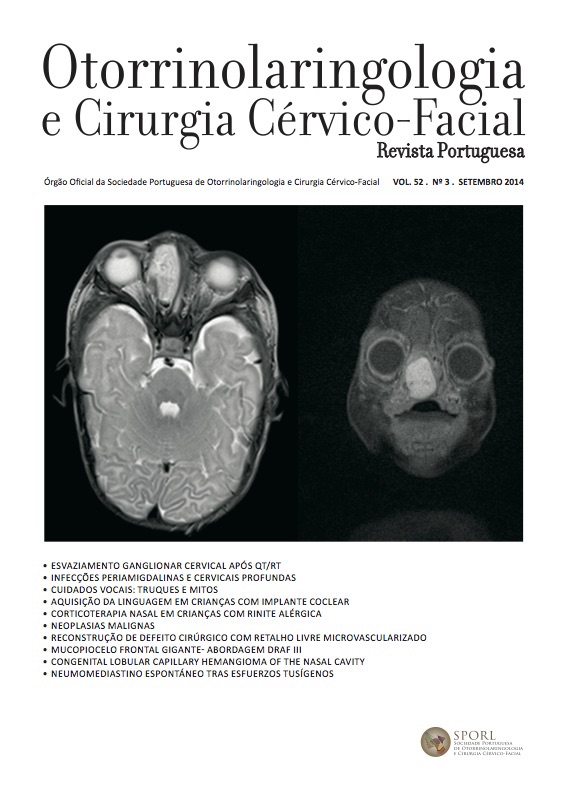Nasal corticotherapy in children with allergic rhinitis - What effect on hypothalamic-pituitary-adrenal axis and growth?
DOI:
https://doi.org/10.34631/sporl.450Keywords:
allergic rhinitis, children, nasal corticosteroids, systemic side effects, hypothalamic-pituitary-adrenal axis, growthAbstract
Objective: To review the literature concerning the safety of nasal corticosteroids in the treatment of allergic rhinitis in children, emphasizing the risk of hypothalamic-pituitary-adrenal axis suppression and growth retardation.
Material and methods: We reviewed scientific articles published between 2000 and 2010, excluding those describing the use of corticotherapy for any disease other than allergic rhinitis.
Results: The second generation nasal corticosteroids (fluticasone and mometasone) have a reduced risk of systemic side effects, due to lower bioavailability. We found that no nasal corticosteroids were associated with hypothalamic-pituitary-adrenal axis suppression in the recommended doses; although we found two studies implicating beclomethasone and budesonide with significant growth retardation, they did not observe the effect on final height.
Conclusion: Nasal corticosteroids do not appear to affect growth significantly in children and thus should be included in the treatment of allergic rhinitis, however with periodic monitoring of growth.
Downloads
References
Bousquet J, Van Cauwenberge P, Khaltaev N. Allergic rhinitis and its impact on asthma. J Allergy Clin Immunol. 2001; 108(5):147-334.
Berger WE. Allergic rhinitis in children: diagnosis and management strategies. Paediatr. Drugs. 2004; 6(4):233-50.
Craig TJ, Teets S, Lehman EB, Chinchilli VM, et al. Nasal congestion secondary to allergic rhinitis as a cause of sleep disturbance and daytime fatigue and the response to topical nasal corticosteroids. J Allergy Clin Immunol. 1998; 101(5):633-37.
Dykewicz MS, Fineman S, Skoner DP, Nicklas R, et al. Diagnosis and management of rhinitis: complete guidelines of the Join Task Force on Practice Parameters in Allergy, Asthma and Immunology. Ann. Allergy Asthma Immunol. 1998;85:478-518.
Baena-Cagnani CE. Safety and tolerability of treatments for allergic rhinitis in children. Drug Safety. 2004; 27(12):883-98.
Demoly P. Safety of intranasal corticosteroids in acute rhino sinusitis. Am J of Otolaryngol. 2008; 29(6):403-13.
Hochhaus G, Sahasranaman S, Derendorf H, Möllmann H. Intranasal glucocorticoid delivery: competition between local and systemic effects. STP Pharma Sciences. 2002; 12:23-31.
Lipworth BJ, Jackson CM. Safety of inhaled and intranasal corticosteroids: lessons for the new millennium. Drug Saf. 2000;23(1):11-33.
Trangsrud AJ, Whitaker AL, Small RE. Intranasal corticosteroids for allergic rhinitis. Pharmacotherapy. 2002; 22:1458-67.
Rohatagi S, Bye A, Falcoz C, Mackie AE, et al. Dynamic modeling of cortisol reduction after inhaled administration of fluticasone propionate. J Clin Pharmacol. 1996; 36(10):938-41.
Daley-Yates PT, Richards HR. Pharmacokinetic and pharmacodynamic relationships for intranasal corticosteroids (INCS). J Allergy Clin Immunol. 2001; 107(2):362-375.
Boner AL. Effects of intranasal corticosteroids on the hypothalamicpituitary-adrenal axis in children. J Allergy Clin Immunol. 2001;108(1):32-9.
Agertoft L, Wolthers OD, Fuglsang G, Pedersen S. Nasal powder administration of budesonide for seasonal rhinitis in children and adolescents. Pediatr Allergy Immunol. 1993; 4(3):152-56.
Synnerstad B, Lindqvist N. A clinical comparison of intranasal budesonide with beclometasone dipropionate for perennial allergic rhinitis: a 12 month study. Br J Clin Pract. 1996; 50(7):363-66.
Wihl JA, Andersson KE, Johansson SA. Systemic effects of two nasally administered glucocorticosteroids. Allergy. 1997; 52(6):620-26.
Passalacqua G, Canonica G, Bachert P, Davies RJ, et al. Inhaled and nasal corticosteroids: safety aspects. Allergy. 2000; 55:16-33.
Grossman J, Banov C, Bronsky EA, Nathan RA. Fluticasone propionate aqueous nasal spray is safe and effective for children with seasonal allergic rhinitis. Pediatrics. 1993; 92(4):594-99.
Knutsson U, Stierna P, Marcus C, Carlstedt-Duke J, et al. Effects of intranasal glucocorticoids on endogenous glucocorticoid peripheral and central function. J Endocrinol. 1995; 144(2):301-10.
Brannan MD, Herron JM, Affrime MB. Safety and tolerability of once-daily mometasone furoato aqueous nasal spray in children. Clin Ther. 1997; 19(6):1330-39.
Davies RJ, Nelson HS. Once-daily mometasone furoato nasal spray: efficacy and safety of a new intranasal glucocorticoid for allergic rhinitis. Clin Ther. 1997; 19(1):27-38.
Galant SP, Wilkinson R. Clinical prescribing of allergic rhinitis medication in the preschool and young school age child. BioDrugs. 2001; 15(7):453-63.
David PS, Gary SR, Eli OM, Paul C, et al. Detection of growth suppression in children during treatment with intranasal
beclomethasone dipropionate. Pediatrics. 2000; 105(2):1-7.
Valotis A, Högger P. Human receptor kinetics and lung tissue retention of the enhanced affinity glucocorticoid fluticasone furoate. Respir Res (Online Ed.) 2007; 8(1):54.
Gradman J, Caldwell MF, Wolthers OD. A 2-week, crossover study to investigate de effect of fluticasone furoate nasal spray on shortterm growth in children with allergic rhinitis. Clinical therapeutics. 2007; 29(8):1738-47.






